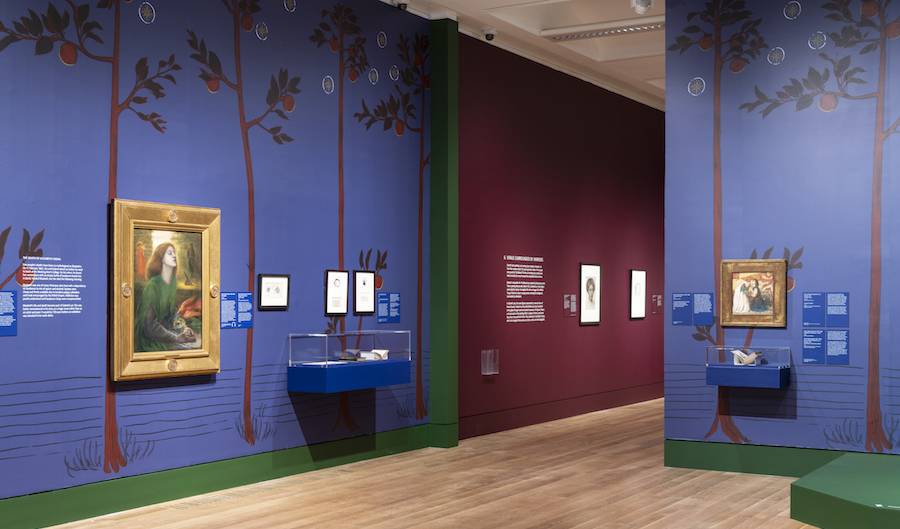Critics have a problem with the Pre-Raphaelites. Reviews to date, of The Rossettis exhibition at Tate Britain, until 24 September, has provided both an opportunity for a critique of the Pre-Raphaelites and the design of and premises for this exhibition.
Curators have been seeking to rehabilitate the Pre-Raphaelites as revolutionary artists for some time. Still, their efforts to do so are easily undercut by the breadth of Pre-Raphaelite activity, some of which was undoubtedly radical while some were simply symptomatic of their time. We also have a tendency to look back critically from within the norms of our time, which, in relation to the Pre-Raphaelites, means that much of their activity looks distinctly patriarchal, although some of what they did and said was emancipatory in its context. The exhibition seeks to grapple with those paradoxes and that intent shapes its design and movement.
At the end of the day, Britain’s first avant-garde movement did not kickstart modern art in the way that Impressionism did in France and that is often the principal beef that critics of Pre-Raphaelitism have with it. The Pre-Raphaelites wanted to go back to the future – back to the art before Raphael – to create something new in the present. As such, they were medievalists, although with a romantic view of medievalism that has gone on to shape elements of Fantasy Art. Their truth-to-nature ethos made them precursors to hyper-realism, while their love of narrative and Symbolism made them precursors of Symbolism. They were aligned with the spirituality of the Oxford Movement with its High Church and Roman Catholic commitments. This also connected to their interest in social action and socialism, both of which informed the beginnings of the Arts and Crafts Movement, which sought to democratise the Arts and restore or decorate churches—in addition to the Arts and Crafts Movement, which emerged directly from Pre-Raphaelitism, the Aesthetic Movement, as this exhibition explores, also emerged from their initial revolt. So, while their influence extends to several interesting strands of modern art, that influence is not central to the development of modern art in the way that Impressionism proved to be and is primarily figurative and literary, in contrast to the abstract and conceptual strands that eventually emerged from the new movements begun by Impressionism.

The Rossettis Photo Courtesy Tate Britain
These are, however, arguments from a past when the developments of modern art still felt contestable, although they are clearly strongly held by some current critics. Post-modernism, with its emphasis on hidden or overlooked stories, has taught us to value the stories that the curators of The Rossettis uncover in constructing their argument that some of the myths about the Pre-Raphaelites are just that, myths. That can be seen here when, for example, the work of Elizabeth Siddall and that of Dante Gabriel Rossetti is examined alongside that of the other. The picture that emerges is not the simple myth of an exploited woman but of influence extending beyond death which derives from natural talent and vision.
Through paintings, drawings, design, poetry, publishing, and more, this exhibition sets out to show and share the impact that the Rossetti’s – principally Dante Gabriel, Christina, and Elizabeth (neé Siddall), with William Michael and Maria supporting in the background – made on Victorian society. That impact, for good or ill, was considerable, as is demonstrated by the fact that exhibitions such as this remain blockbusters and their legacy is as contestable and controversial as it ever was.
The Pre-Raphaelites combined realism with Symbolism, the developments of early photography with the myth of an idealised medievalism, the hyper-real with fantasy, morality with sensuality, truth to nature with spirituality. These are essentially somewhat odd combinations. In the early phase of the Pre-Raphaelite Brotherhood were held together in creative tension but separated, more often than not, in the later work. These tensions in their ideas made their revolution unsustainable – even though it had the vitality to continue into the twentieth century in a third phase – and, as their contradictions unravelled, resulted in work that was sometimes unintelligible, sometimes sentimental, and sometimes enmeshed in an idealised past. Yet, as occurred with the Impressionists, work considered shocking, even ugly, in its day came in time to be viewed as the epitome of beauty.
That one first-generation migrant family should have such an impact is to be celebrated, as is the case with this exhibition. While the exhibition is the first retrospective at the Tate for Dante Gabriel Rossetti, its real achievement is to foreground the Pre-Raphaelite Sisterhood, focused here primarily on Christina and Elizabeth, although with reference, too, to the part Jane Morris played in Morris & Co. Here, the exhibition draws on the research of Jan Marsh and builds on the Watts Gallery’s Christina Rossetti: Vision and Verse from 2018 and the National Gallery’s Pre-Raphaelite Sisters from 2019.

The Rossettis, 2023 Photo Courtesy Tate Britain
Susan Owens and Nicholas Tromans have argued that Christina was unique in being the only major poet who grew up “so deeply embedded in an avant-garde visual culture” where “literature was the warp and visual art the weft.” As a result, her works “have inspired – perhaps even haunted – artists since her poetry first began to be published”, with photographer Julia Margaret Cameron and Belgian Symbolist Fernand Khnopff being among the those outside the initial circle of the PRB to be so inspired. As a result, her work is still more widely known today than that of her brothers.
As Emma Mason has identified, in Christina’s work, we encounter, as with the Tractarian theology and praxis that inspired her, a “compassionate politics” and “a marker of religion’s relevance to modern concerns through its reflections on science and materialism, as well as spirituality and mysticism.” Mason has suggested that Christina’s life and work “capture the experience of faith as one of loving intimacy with the minutiae of creation, a divine body in which all things, material and immaterial, human and nonhuman, divine and embodied, are interconnected.”
We encounter this on entering this exhibition, as Christina’s words are foregrounded on the walls of the first room and whispered to us as we pass trigger points on the floor. The poetry of sister and brother and Gabriel’s paintings often had a personal perspective that Gabriel called an “inner standing point.” They ask the reader or viewer to feel inside the ‘situation’ and mentality of a critical character and it is from this act of empathy that the “emotional influence” of their work derives. Gabriel also often pairs his paintings with his poems to create ‘double works of art’ where words question images and images question words.
By these means, the Rossettis created some of the greatest works combining words and images in the period after the illuminated books of William Blake. Moreover, they did so in ways that mean that their words and images are not simply illustrations of one or the other but conversations in which depth of meaning is found in dialogue rather than didacticism. This is what those who stop and stay with the Pre-Raphaelites discover and it is a depth that eludes those who primarily engage with the stereotype of desperate romantics, whether that stereotype is one that is loved or hated.
Top Photo: The Rossettis Installation View Tate-Britain 2023 © Tate-Madeleine Buddo
THE ROSSETTIS – Tate Britain Until 24 September 2023


